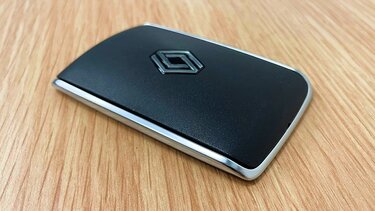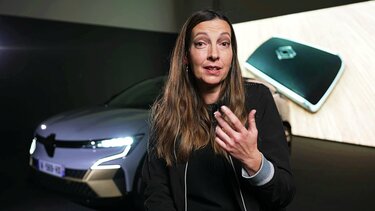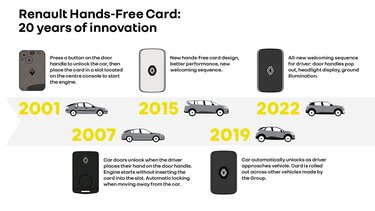Renault hands-free key card: 20 years of innovation in the palm of your hand
07/01/2022
- Overcoming technical challenges, the key card has been reworked many times to make life as easy as possible for its customer
- Pascaline, Head of Cross-Cutting Products at Renault Group, takes us through its history: click here
Pascaline, Head of Cross-Cutting Products at the Renault Group Products division, takes us through the history behind the innovative card. "This innovative solution was designed to make life easier for customers", says Pascaline, Head of Cross-Cutting Products at the Renault Group Products Division.
Quite a few years back...
It all started in 2001. Renault was set to launch the Laguna II, a saloon that was said to embody the ‘lifestyle’ car of 21st century. However, designers felt that the vehicle was still lacking a few innovative features.
Before its official launch, Bernard Dumondel, the Laguna II product lead, was staying in a hotel in Luxembourg. He goes to use his room key – a magnetic card – and has an epiphany: why not use a contactless card instead of the traditional car key? The idea behind the hands-free card was born.
He presents a prototype of his idea to his program manager and impresses the Group’s Executive Committee (including Louis Schweitzer himself, the CEO of Renault during this time). The project is immediately adopted.
Following the 1973 R16 TX – the first French car to have electronic central locking – and the 1982 Fuego with its ground-breaking remote-controlled door locks, Laguna II became the first car made by a general-purpose car manufacturer to feature a hands-free card.
The initial design was known as a ‘keyless entry’. Over the following years, Renault improved the accessory by including it on Espace and Vel Satis models. It then helped popularise the design by extending it across its entire range, from Clio, to Scenic, and on to Mégane. On the latest generation of hands-free cards, the car is unlocked when the badge is approached and locked automatically when it is moved away.
When innovation brings technology and accessibility together
Behind the hands-free card’s minimalist plastic case, hides a sophisticated electronic core. It is programmed to constantly ‘communicate’ with the car it is paired to. This means that when the vehicle is approached, the card is detected by receiver-transmitters located throughout the car. When the vehicle pings the card with a verification request, it emits a radio signal containing an access code. If the car recognises the code, it unlocks the doors.
All this takes only 80 milliseconds, faster than the blink of an eye. When the person holding the hands-free card climbs out of the vehicle, the on-board computer continues to ping the card at regular intervals, to see if it is still in the vicinity. When the card no longer responds, the computer locks all the doors.
Technical uncertainty and hurdles
According to Pascaline, inventing the hands-free card “was a mighty challenge with a fair amount of risk.” Despite its record 5-star Euro NCAP crash test, Laguna II suffered from technical hiccups in the months following its release. This was also the case with the first version of the hands-free card. Its signal could be easily muddled by nearby objects, like the neon lights often found in parking lots.
The underlying technology was, at the time, still in its early stages. Despite an in-depth design brief based on more than 6,000 customer interviews looking at their lifestyles, habits, and expectations, Renault had run out of time to create prototypes, test all possible use-cases, and correct for any unknowns.
In an effort to satisfy customers, Renault engineers and designers reworked the design from top to bottom, to offer an even more powerful option later on down the track.
Over the 20 years since its creation, the Renault hands-free card has gone through constant change. In terms of both its look and especially the technology inside.
In 2001, the very first version made by equipment supplier Valeo was known as the ‘practical’ card. Anyone holding the card could lock and unlock the car by pressing a button located either on the card or on the door handle. The standard version was to be used like a remote control or it could be upgraded to a ‘hands-free’ model. Inside, centre console features a slot for the card and a button to start the engine.
In 2007, Renault moved on to the ‘magic’ card. When carrying the card on their person, a driver only has to grab the door handle for the whole car to unlock. Inside, the card slot has since been removed.
In 2015, Renault launched Espace V, a minivan that came equipped with a more efficient and revamped version of the hands-free card. It also featured a new light and sound welcoming sequence.
In 2019, the design took on the true meaning of the term ‘hands-free’. The car locks and unlocks the doors automatically when the card is brought near or taken far away.
In 2022 , the All-New Mégane E-Tech Electric is going to take the hands-free experience even further. Thanks to more efficient aerials, the card holder is readily detected no matter where they are in a 360° area around the vehicle. The welcome sequence triggers as they approach the vehicle, while the flush door handles – normally hidden within the car body – pop out, and the charging port cover automatically unlocks.
What is the future for the hands-free card?
Always at the forefront of technological innovation, Renault has spent recent years endeavouring to make using the hands-free card even easier to use. The electronic parts housed inside have become even smaller. Its range has been extended and its battery life has been optimised. As for security, recent updates have made the system even harder to hack.
While smartphones appear to be on the verge of replacing cards, Renault has chosen to harness their new capabilities without letting the hands-free card fall to the wayside. In 2021, the Renault vehicle equipment orders prove that customers are very fond of the card accessory. They were included on nearly two in every three Renault vehicles sold.
- Overcoming technical challenges, the key card has been reworked many times to make life as easy as possible for its customer
- Pascaline, Head of Cross-Cutting Products at Renault Group, takes us through its history: click here
Pascaline, Head of Cross-Cutting Products at the Renault Group Products division, takes us through the history behind the innovative card. "This innovative solution was designed to make life easier for customers", says Pascaline, Head of Cross-Cutting Products at the Renault Group Products Division.
Quite a few years back...
It all started in 2001. Renault was set to launch the Laguna II, a saloon that was said to embody the ‘lifestyle’ car of 21st century. However, designers felt that the vehicle was still lacking a few innovative features.
Before its official launch, Bernard Dumondel, the Laguna II product lead, was staying in a hotel in Luxembourg. He goes to use his room key – a magnetic card – and has an epiphany: why not use a contactless card instead of the traditional car key? The idea behind the hands-free card was born.
He presents a prototype of his idea to his program manager and impresses the Group’s Executive Committee (including Louis Schweitzer himself, the CEO of Renault during this time). The project is immediately adopted.
Following the 1973 R16 TX – the first French car to have electronic central locking – and the 1982 Fuego with its ground-breaking remote-controlled door locks, Laguna II became the first car made by a general-purpose car manufacturer to feature a hands-free card.
The initial design was known as a ‘keyless entry’. Over the following years, Renault improved the accessory by including it on Espace and Vel Satis models. It then helped popularise the design by extending it across its entire range, from Clio, to Scenic, and on to Mégane. On the latest generation of hands-free cards, the car is unlocked when the badge is approached and locked automatically when it is moved away.
When innovation brings technology and accessibility together
Behind the hands-free card’s minimalist plastic case, hides a sophisticated electronic core. It is programmed to constantly ‘communicate’ with the car it is paired to. This means that when the vehicle is approached, the card is detected by receiver-transmitters located throughout the car. When the vehicle pings the card with a verification request, it emits a radio signal containing an access code. If the car recognises the code, it unlocks the doors.
All this takes only 80 milliseconds, faster than the blink of an eye. When the person holding the hands-free card climbs out of the vehicle, the on-board computer continues to ping the card at regular intervals, to see if it is still in the vicinity. When the card no longer responds, the computer locks all the doors.
Technical uncertainty and hurdles
According to Pascaline, inventing the hands-free card “was a mighty challenge with a fair amount of risk.” Despite its record 5-star Euro NCAP crash test, Laguna II suffered from technical hiccups in the months following its release. This was also the case with the first version of the hands-free card. Its signal could be easily muddled by nearby objects, like the neon lights often found in parking lots.
The underlying technology was, at the time, still in its early stages. Despite an in-depth design brief based on more than 6,000 customer interviews looking at their lifestyles, habits, and expectations, Renault had run out of time to create prototypes, test all possible use-cases, and correct for any unknowns.
In an effort to satisfy customers, Renault engineers and designers reworked the design from top to bottom, to offer an even more powerful option later on down the track.
Over the 20 years since its creation, the Renault hands-free card has gone through constant change. In terms of both its look and especially the technology inside.
In 2001, the very first version made by equipment supplier Valeo was known as the ‘practical’ card. Anyone holding the card could lock and unlock the car by pressing a button located either on the card or on the door handle. The standard version was to be used like a remote control or it could be upgraded to a ‘hands-free’ model. Inside, centre console features a slot for the card and a button to start the engine.
In 2007, Renault moved on to the ‘magic’ card. When carrying the card on their person, a driver only has to grab the door handle for the whole car to unlock. Inside, the card slot has since been removed.
In 2015, Renault launched Espace V, a minivan that came equipped with a more efficient and revamped version of the hands-free card. It also featured a new light and sound welcoming sequence.
In 2019, the design took on the true meaning of the term ‘hands-free’. The car locks and unlocks the doors automatically when the card is brought near or taken far away.
In 2022 , the All-New Mégane E-Tech Electric is going to take the hands-free experience even further. Thanks to more efficient aerials, the card holder is readily detected no matter where they are in a 360° area around the vehicle. The welcome sequence triggers as they approach the vehicle, while the flush door handles – normally hidden within the car body – pop out, and the charging port cover automatically unlocks.
What is the future for the hands-free card?
Always at the forefront of technological innovation, Renault has spent recent years endeavouring to make using the hands-free card even easier to use. The electronic parts housed inside have become even smaller. Its range has been extended and its battery life has been optimised. As for security, recent updates have made the system even harder to hack.
While smartphones appear to be on the verge of replacing cards, Renault has chosen to harness their new capabilities without letting the hands-free card fall to the wayside. In 2021, the Renault vehicle equipment orders prove that customers are very fond of the card accessory. They were included on nearly two in every three Renault vehicles sold.







